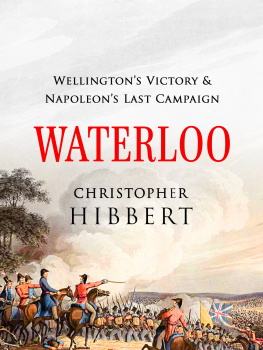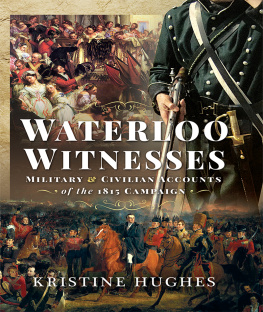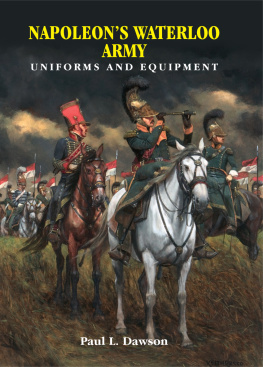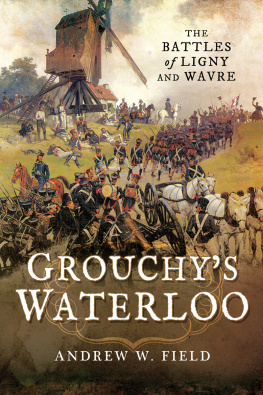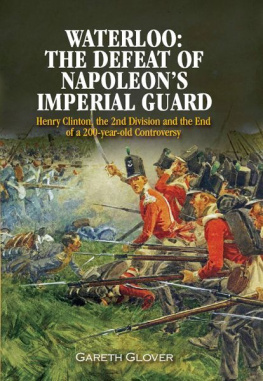WATERLOO
The Campaign of 1815
Volume 2
Napoleons letter from Rochefort, dated 13 July 1815, surrendering to the Prince Regent. (Royal Collection)
WATERLOO
The Campaign of 1815
Volume 2
FROM WATERLOO
TO THE
RESTORATION OF PEACE IN EUROPE
John Hussey
Foreword by
Major General Mungo Melvin
Greenhill Books
Waterloo, The Campaign of 1815
This edition published in 2017 by
Greenhill Books,
c/o Pen & Sword Books Ltd,
47 Church Street, Barnsley,
S. Yorkshire, s70 2AS
www.greenhillbooks.com
ISBN: 978-1-78438-200-1
eISBN: 978-1-78438-202-5
Mobi ISBN: 978-1-78438-201-8
All rights reserved.
John Hussey, 2017
Foreword Major General Mungo Melvin, 2017
The right of John Hussey to be identified as author of this work has been asserted in accordance with Section 77 of the Copyrights Designs and Patents Act 1988.
CIP data records for this title are available from the British Library
Designed and typeset by Donald Sommerville
Maps by Peter Wilkinson
The lyf so short, the craft so long to lerne,
Thassay so hard, so sharp the conquering.
Geoffrey Chaucer, The Parlement of Fowles
If I have seen further it is by standing on the shoulders of Giants.
Isaac Newton to Robert Hooke, 1676
Contents
Plates and Illustrations
Plates
The Duke of Wellington in 1814, by Sir Thomas Lawrence (17691830). ( Historic England Archive )
Lieutenant-General Lord Hill. ( Anne S. K. Brown Military Collection [ ASKB ])
Lord Fitzroy Somerset, watercolour by William H. Haines (181284). ( ASKB )
The bridge at Genappe. ( Muse Wellington, Waterloo )
The charge of the British heavy cavalry. ( Muse Wellington, Waterloo )
Closing the gates at Hougoumont (1903), by Robert Gibb (18451932). ( National Museums Scotland )
French attack on La Haye Sainte, by Richard Kntel (18571914). ( ASKB )
British squares receiving a French cavalry charge (1874), by Flix Philippoteaux (181584). ( Victoria and Albert Museum )
French and Prussian troops in Plancenoit, 1818 watercolour by Charles Warren (17621823). ( ASKB )
General Graf Gneisenau, 1819 engraving by B. Smith, after A. W. Devis (17621822). ( ASKB )
General Lobau, colour lithograph of 1835, after a painting by Antoine Maurin (17931860). ( ASKB )
The field of Waterloo (1818), by J. M. W. Turner (17751851). ( Fitzwilliam Museum, Cambridge )
Moonlight pursuit of the French Army, 1818 watercolour by Charles Warren. ( ASKB )
Napoleon surrendering on HMS Bellerophon , 1816 aquatint by Thomas Sutherland, after a painting by William Heath (17941840). ( ASKB )
Maps, Diagrams and Tables
Maps
Main Theatre of Operations
Waterloo, 18 June 1815 the Topography
Waterloo, 11.1511.30 a.m., 18 June 1815
Hougoumont and La Haye Sainte
Hougoumont, June 1815
La Haye Sainte, June 1815
DErlons Attack Begins, approximately 2.30 p.m.
The Cavalry Attacks Begin, approximately 4 p.m.
The Prussians: Wavre 17/18 June 1815
The Prussian March: 18 June 1815
Wavre, About 5 p.m., 18 June 1815
Plancenoit, 18 June 1815
The Garde Attacks, 7.15 to 7.30 p.m.
Waterloo, 7.45 p.m., 18 June 1815
Wavre, About 10 a.m., 19 June 1815
French and Prussian Movements, 1819 June 1815
The March to Paris after Waterloo: Northern Sector
The March to Paris after Waterloo: Southern Sector
Paris Defences, June 1815
Napoleon and HMS Bellerophon , July 1815
The Second Treaty of Paris, 20 November 1815
Army Dispositions for 13 June: the 10 June order of the day
Army Dispositions for 13 June: the 10 June Bertrand letter
Charts and Diagrams
Section: From the Forest of Soignies to Genappe Bridge
La Rente , French Government Funds, 1815
Tables
Wellingtons Field and Horse Artillery, 1815
Balance of Forces at Waterloo
French Heavy Cavalry Casualties
DutchBelgian Heavy Cavalry Casualties
Garde Infantry Casualties
Wellingtons Casualties
Foreword
by Major General (retd) Mungo Melvin, cb, obe
EDWARD CREASYS CLASSIC WORK of military history, The Fifteen Decisive Battles of the World , was first published in 1851, the year of the Great Exhibition. With this demonstration of British industrial prowess in mind, Creasy triumphantly concluded his account of Waterloo, his fifteenth battle, by claiming that no battlefield:
ever witnessed a victory more noble, than that, which England, under her Sovereign Lady and her Royal Prince, is now teaching the peoples of the earth to achieve over selfish prejudices and international feuds, in the great cause of the general promotion of the industry and welfare of mankind.
Although such patriotic bombast reads oddly today, it must be remembered that Creasy penned his words at nearly the midpoint of Britains long peace following the Napoleonic Wars. The brief interruption of the Crimean War had yet to break the heady national optimism of the times.
While Napoleon had certainly lost the Battle of Waterloo on 18 June 1815, Wellington only had secured victory over the French with the assistance of Blchers Prussians. Yet overall Britain won the resultant peace. This second volume of John Husseys magisterial account of the Waterloo campaign helps explain why. Wellington, as commander-in-chief of the Anglo-Allied army, not only fought Napoleons proud army to a standstill on the low ridge of Mont St Jean, thus garnering much military prestige and glory in the process, but also exercised a moderating influence in the Allied cause thereafter. Rather than seeking a destructive vengeance on the French, as the Prussians were bent on, Wellingtons diplomatic skills as a political general helped shape the capitulation of Paris on 3 July 1815, which effectively terminated both the Waterloo campaign, and the Napoleonic Wars as a whole, without further recourse to costly battle.
Waterloo, famously, had been a close-run affair of hard pounding, coming two days after the preliminary actions at Ligny and Quatre Bras on 16 June 1815, both described in detail in Volume 1. In terms of intensity of casualties in both short time and confined space, Waterloo was probably the hardest and closest-fought battle of the Napoleonic era. The explanation is quite simple: there was little to distinguish between the armies concerned in either quality or quantity. Therefore it is entirely apt in my view for John Hussey to quote from Field Marshal Sir Douglas Haigs final despatch following the end of the First World War:
In every stage of the wearing-out struggle losses will necessarily be heavy on both sides, for in it the price of victory is paid. If the opposing forces are approximately equal in numbers, in courage, in morale and in equipment, there is no way of avoiding payment of the price or of eliminating this phase of the struggle.


